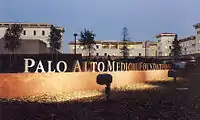Palo Alto Medical Foundation
The Palo Alto Medical Foundation for Health Care, Research and Education (PAMF) is a not-for-profit health care organization with medical offices in more than 15 cities in the Bay Area. It has more than 900 physicians and had over 2 million patient visits in 2008.[1] It is rated as one of California's top medical groups.[2]
 | |
| Type | Nonprofit |
|---|---|
| Industry | Healthcare |
| Founded | 1930 |
| Founder | Dr. Russel Van Arsdale Lee |
| Headquarters | Palo Alto, California, USA |
| Website | https://www.sutterhealth.org/pamf |
History
The history of the group dates back to 1930, when Dr. Russel Van Arsdale Lee founded the Palo Alto Medical Clinic (PAMC).[3] Within a few years, several physicians joined Dr. Lee, including Edward F. Roth, Blake C. Wilbur, Herbert Niebel, Milton Saier and Esther Clark, one of the first female physicians in the country.[4] In 1946 — before health plans were standard business — PAMC agreed to provide medical care to nearby Stanford University students in exchange for a flat fee.[5] In 1950, it became one of the first facilities in the nation to offer radiation therapy for cancer patients in an outpatient setting.[6]
In 1981, the for-profit physician group PAMC created the not-for-profit PAMF to control its operations and assets, and in 1993, PAMF became an affiliate of Sutter Health, a not-for-profit organization with hospitals and medical groups in Northern California.[7] In 1999, it was a very early adopter of an electronic health record system.[8] In 2008, PAMF's three medical groups — Camino Medical Group, Palo Alto Medical Clinic, and Santa Cruz Medical Clinic — merged to form a single medical group, Palo Alto Foundation Medical Group (PAFMG).[9] In 2017 the Peninsula Medical Clinic (PMC) of Burlingame, joined PAFMG as the Mills Peninsula Division of the medical group.[10]
Education and research
In addition to its Health Care Division, PAMF consists of an Education Division and Research Institute. The Education Division provides classes, lectures, support groups and consultations, and manages PAMF's Community Health Resource Centers located in several Bay Area cities. The Research Institute, located in Palo Alto, has more than 30 staff members conducting clinical studies in four departments: health services, clinical research, health policy research, and cardiovascular physiology and biophysics. In 2009, the National Institutes of Health awarded the institute more than $2 million in federal stimulus grants through the American Recovery and Reinvestment Act.[11]
PAMF provides an e-health service that allows patients to view their records and test results from their personal computers, and request appointments and prescription renewals online. In 2008, it launched a pilot program to promote online communication between diabetic patients and their health care providers.[8]
Structure
PAMF is a multi-specialty group practice, comprising physicians from all of the usual specialties. It is part of the Sutter Health Bay Area Operating Unit, which also includes Mills Peninsula Health Services, Menlo Park Surgical Hospital, and Sutter Maternity and Surgical Center of Santa Cruz. PAMF is governed by the Sutter Health Peninsula Coastal Region Board of Directors and a Community Board of Trustees. Its physicians are led by the Palo Alto Medical Foundation Group Board of Directors. The group's administration is headed by a Chief Executive Officer, and presidents of the five geographical divisions: Santa Cruz, Palo Alto, Camino, Alameda and Mills Peninsula.
Awards
- In 2009, PAMF was named a top performer by the Integrated Healthcare Association, which ranks California medical groups on clinical quality, patient experience, use of information technology and coordinated diabetes care.[12]
- In 2009, its Chief Medical Information Officer, Dr. Paul Tang, was listed on Modern Healthcare's list of 100 Most Powerful People in Healthcare.[13]
References
- "Palo Alto Medical Foundation at a Glance: 2011 Statistics". Palo Alto Medical Foundation. May 2012. Retrieved 21 November 2012.
- Integrated Healthcare Association (2011). "Top Medical Groups Where You Live". California Office of the Patient Advocate. Retrieved 21 November 2012.
- Palo Alto Medical Foundation (2005). "The Clinic is Born". Palo Alto Medical Clinic: The First 75 Years. Retrieved 21 November 2012.
- Palo Alto Medical Foundation (2005). "The Practice's First Days". Palo Alto Medical Clinic: The First 75 Years. Retrieved 21 November 2012.
- Palo Alto Medical Foundation (2005). "A Brief History of Group Practice". Palo Alto Medical Clinic: The First 75 Years. Retrieved 21 November 2012.
- Palo Alto Medical Foundation (2005). "Timeline: 1930–2005". Palo Alto Medical Clinic: The First 75 Years. Retrieved 21 November 2012.
- Palo Alto Medical Foundation (2005). "A Novel Type of Health Care Corporation". Palo Alto Medical Clinic: The First 75 Years. Retrieved 21 November 2012.
- Solovitch, Sara (21 January 2008). "PAMF hopes its online info system bucks trend". San Francisco Business Times. Retrieved 21 November 2012.
- "About Palo Alto Medical Foundation". Palo Alto Medical Foundation. Retrieved 21 November 2012.
- www.bizjournals.com https://www.bizjournals.com/sanfrancisco/stories/2009/12/07/daily48.html. Retrieved 2020-08-19. Missing or empty
|title=(help) - Rauber, Chris (23 November 2009). "PAMF's Research Institute wins $2M+ in federal stimulus grants". San Francisco Business Times. Retrieved 21 November 2012.
- Rauber, Chris (21 September 2009). "IHA names top California medical groups on P4P". San Francisco Business Times. Retrieved 21 November 2012.
- "100 Most Powerful People in Healthcare". Modern Healthcare. 2009. Retrieved 21 November 2012.
